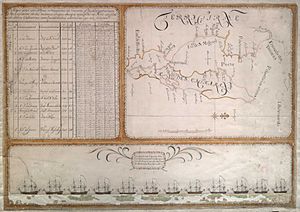Spanish–Portuguese War (1776–1777) facts for kids
Quick facts for kids Spanish–Portuguese War (1776–1777) |
|||||||
|---|---|---|---|---|---|---|---|
| Part of the Spanish–Portuguese wars | |||||||
|
|||||||
| Belligerents | |||||||
| Commanders and leaders | |||||||
|
|||||||
| Strength | |||||||
|
1,450 initially 9,000 expeditionary corps |
6,000 | ||||||
The Spanish-Portuguese War was a conflict that happened between 1776 and 1777. It was also called the Second Cevallos Expedition. This war was fought over the borders between the lands controlled by Spain and Portugal in South America.
Contents
Why the War Started: Border Disputes
This war was not the first time Spain and Portugal fought over land in South America. In an earlier war (1762–1763), Spanish forces took control of several places. These included Colonia del Sacramento, Santa Tecla, San Miguel, Santa Teresa, and Rio Grande de São Pedro.
After that war, Colonia del Sacramento was given back to Portugal. But other areas like Santa Tecla and Rio Grande de São Pedro stayed under Spanish control. This made Portugal unhappy.
Portuguese Attack on Spanish Lands
Starting in 1767, the Portuguese began getting their troops ready. They also started bothering the Spanish in the border areas. Over several years, Portugal built up a large army of 6,000 soldiers. This was much more than the 1,450 Spanish troops in the region.
Things became serious in February 1776. Two Portuguese fleets, led by Robert MacDouall and Jorge Hardcastle, arrived. They landed troops near the fortress of Rio Grande de São Pedro. Then, they started attacking the Spanish fort with cannons.
A Spanish fleet, led by Francisco Javier Morales, fought back. After a three-hour battle, the Spanish fleet forced the Portuguese ships to leave. The Spanish lost 6 men and had 24 wounded. The Portuguese lost two ships.
However, the Portuguese soldiers on land kept moving forward. The Spanish commander, Juan José de Vértiz y Salcedo, had to pull his troops back. This meant the Spanish lost control of the entire Rio Grande area.
Peace and New Borders
The war ended on February 24, 1777. This was because King Joseph I of Portugal died. His daughter, Maria I, became the new queen. She wanted peace.
On October 1, 1777, Portugal and Spain signed the First Treaty of San Ildefonso. This treaty set new borders for their lands in South America.
- Spain gave the island of Santa Catarina back to Portugal.
- Spain also agreed that Rio Grande de São Pedro belonged to Portugal.
- But Spain kept the important port city of Colonia del Sacramento. This city was located on the River Plate. Spain also kept the rest of the Banda Oriental (which is now Uruguay) and the Misiones Orientales.
- In return, Spain agreed that Portugal's lands in Brazil stretched much farther west than an old border line from the Treaty of Tordesillas.
Later, in the Treaty of El Pardo (signed March 11, 1778), Spain gained Spanish Guinea (now Equatorial Guinea). This area was managed from Buenos Aires for many years. Spain held it until 1968.
What Happened Next
One important result of this war was that Portugal stayed neutral in another big conflict. This was the American War of Independence. When France (1778) and Spain (1779) joined the war against Britain, Portugal did not get involved.
Portugal had an agreement with Britain. However, Portugal was disappointed that Britain did not help them against Spain in their recent war. So, Portugal decided not to join the American War of Independence. Instead, Portugal joined the First League of Armed Neutrality in 1781. This group aimed to stop Britain from taking cargo from neutral ships during the war.
See also
 In Spanish: Segunda expedición de Cevallos a Río Grande para niños
In Spanish: Segunda expedición de Cevallos a Río Grande para niños
- Military history of Spain
- Military history of Portugal
- List of wars involving Spain
- List of wars involving Portugal
- Portuguese Armed Forces
- Spanish Armed Forces
Sources
- Guerras entre España y Portugal en la cuenca del Río de la Plata
- EXPEDICIÓN A LA COLONIA DEL SACRAMENTO (1776 - 1777)



